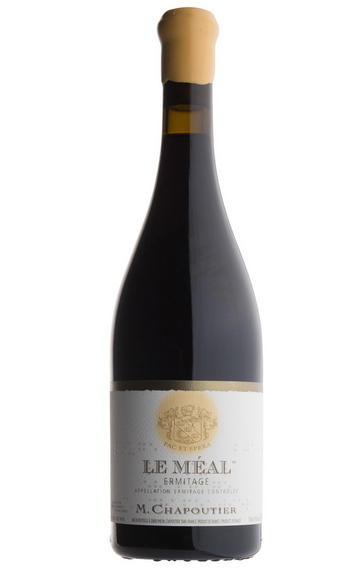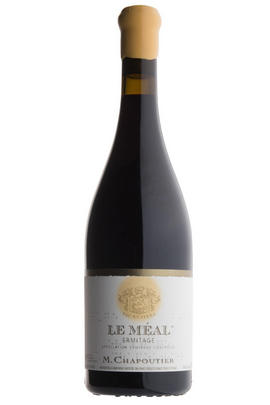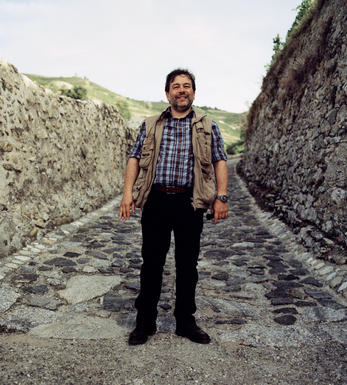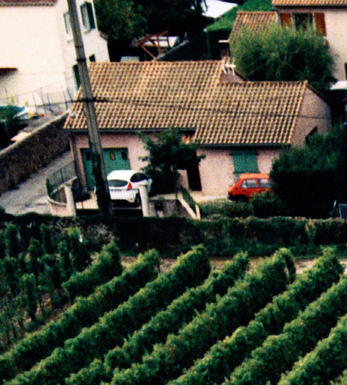
2012 Ermitage Rouge, Le Méal, M. Chapoutier, Rhône

Critics reviews
This was an incredible tasting with Michel Chapoutier and his second hand man, Pierre-Henri Morel. Certainly one of the success stories in wine, which Robert Parker does a fabulous job of detailing in Issue 204, this estate goes from strength to strength in just about every appellation in the Rhone Valley. Looking specifically at Hermitage, Chapoutier owns a massive 64 acres, mostly on the famed Bessards lieu-dit, yet also with significant portions on Le Meal, L’Ermite and Les Greffieux, with smaller portions in the Beaume and Murets lieux-dits. From this he fashions five reds (Monier De La Sizeranne, Les Greffieux, Le Meal, Le Pavillon and L’Ermite) and four whites (Chante Alouette, Cuvee de l’Oree, Le Meal Blanc and L’Ermite Blanc), all of which are brilliant wines, with the best ranking up alongside the top wines in the world.
In addition, his Saint Josephs (Les Granits and Le Clos) are some of the leading wines of the appellation (along with Guigal’s Vignes de l’Hospice and a few others), and his Cote Rotie La Mordoree, which comes from his 12 acres (split between the roughly defined Cote Blonde and Cote Brune regions), is always a classic example of the appellation.
Jeb Dunnuck - Wine Advocate #210, Dec 2013
About this WINE

Maison Chapoutier
Applying his usual break-neck rigour to the presidency of InterRhône has not in any way distracted Michel Chapoutier. His range is more impressive in scope than ever, providing the most complete dissection of the region’s styles and terroir. Founded in 1808, Michel took charge in 1988 and became the seventh generation of his family to run the domaine. Since then, quality has soared and he is now farming all his vineyards biodynamically. He also invests in new winemaking projects across the globe, as far-flung as Australia. His children, in particular his daughter, Mathilde, are now increasingly involved in the day-to-day management of the maison, bringing with her her entrepreneurial skills and vision.
Michel describes 2021 as a vintage the vignerons were unlikely to forget in a hurry, bringing an array of challenges that only hard work could overcome. It also brought a style of wines he thought long forgotten: ethereal in nature, with aromatic complexity, lower alcohols and bright acidities. They offer great elegance and finesse overall.
You might remember that we offered Chapoutier’s 2021 sélection parcellaire back in October last year – an impressive range of his single vineyards, including his prestigious Ermitages. We do have small volumes left of some lines so if you’re interested in seeing a complete list, please speak to your Account Manager.
Hermitage
Hermitage is the most famous of all the northern Rhône appellations. The hill of Hermitage is situated above the town of Tain and overlooks the town of Tournon, just across the river. Hermitage has 120 hectares and produces tiny quantities of very long-lived reds.
The vines were grown in Roman times, although local folklore claims their origins to be nearly 600 years earlier. The name ‘Hermitage’ first appeared in the 16th century, derived from a legend of the 13th century Crusade, involving a wounded knight called Gaspard de Stérimberg, who made refuge on the hill, planted vines and became a hermit.
During the 17th century, Hermitage was recognised as one of the finest in Europe. In 1775, Château Lafite was blended with Hermitage and was one of the greatest wines of its day. In the late 19th century, however, Phylloxera wiped out all the vineyards.
The wines are powerful, with a deep colour and firm tannins, developing into some of the finest examples in France, with the potential to age for many decades. The best Hermitage is produced from several climats or more, blended together. The main climats are Les Bessards, Le Meal, L’Hermite, Les Greffieux and Les Diognieres. Most of the finest climats face broadly south, giving maximum sunshine. Most growers only have one or two climats and they might not complement each other; Hermitage quality can therefore vary hugely. Only the top producers have extensive diversified holdings.
80% of the wine produced is red, however up to 15% of white grapes can be used in the blend. Most growers use 100% Syrah and utilise the white grapes to make white wines only. Chapoutier, Jaboulet and Tain l'Hermitage are the principal proprietors of the appellation’s vineyards.
The white wines are made from the Marsanne and Roussanne grapes. Great white Hermitage can age, taking on the fruit characters of apricots and peaches, often giving a very nutty finish. The best examples in great vintages can last 50 years.
Mature red Hermitage can be confused with old Bordeaux. In a blind tasting of 1961 First Growth Clarets, the famous 1961 Hermitage La Chapelle was included. Most people, including its owner, Gerard Jaboulet, mistook it for Château Margaux.

Syrah/Shiraz
A noble black grape variety grown particularly in the Northern Rhône where it produces the great red wines of Hermitage, Cote Rôtie and Cornas, and in Australia where it produces wines of startling depth and intensity. Reasonably low yields are a crucial factor for quality as is picking at optimum ripeness. Its heartland, Hermitage and Côte Rôtie, consists of 270 hectares of steeply terraced vineyards producing wines that brim with pepper, spices, tar and black treacle when young. After 5-10 years they become smooth and velvety with pronounced fruit characteristics of damsons, raspberries, blackcurrants and loganberries.
It is now grown extensively in the Southern Rhône where it is blended with Grenache and Mourvèdre to produce the great red wines of Châteauneuf du Pape and Gigondas amongst others. Its spiritual home in Australia is the Barossa Valley, where there are plantings dating as far back as 1860. Australian Shiraz tends to be sweeter than its Northern Rhône counterpart and the best examples are redolent of new leather, dark chocolate, liquorice, and prunes and display a blackcurrant lusciousness.
South African producers such as Eben Sadie are now producing world- class Shiraz wines that represent astonishing value for money.


Buying options
Add to wishlist
Description
Our 2012 Rhône Vintage Recommendation: Favourite Northern Rhône
This, for me, was really the most improved estate we tasted at: over the last five years the wines have moved from being solid and perfectly respectable to having more charm and personality. This has all the power you would expect of this top Hermitage vineyard: what is unexpected is its aristocratic nature, pure lifted fruit, purity with olives and bramble fruits.
Matt Tipping, Private Account Manager
Quite closed on the nose, but much more forward on the palate, with lovely, fine concentration. It's lifted with floral and black fruit such as violets and blackberries. Crisp acidity and fine tannins, with lovely class and definition.
Chris Pollington, Private Account Manager
wine at a glance
Delivery and quality guarantee